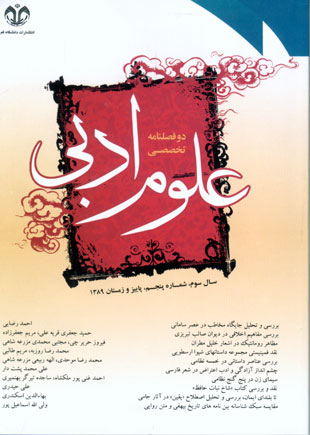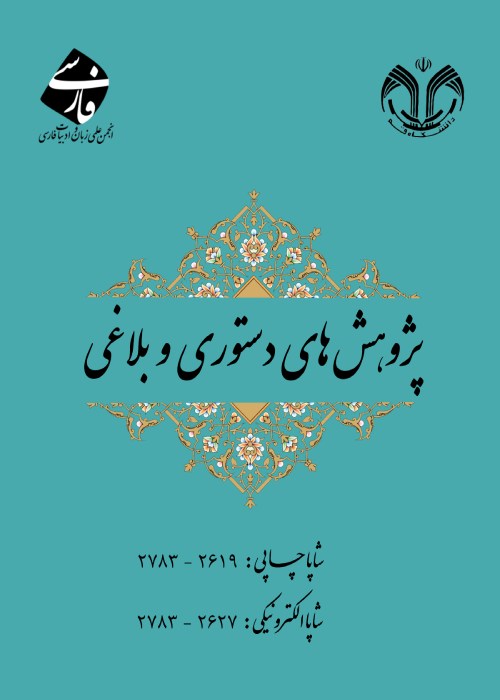فهرست مطالب

نشریه پژوهش های دستوری و بلاغی
پیاپی 5 (پاییز و زمستان 1389)
- تاریخ انتشار: 1389/12/17
- تعداد عناوین: 10
-
صفحه 125
-
صفحه 181
-
صفحه 199
-
Page 7In composing a literary work different elements are involved. The four following onesare among the most effective elements:a. political and social situationsb. literary traditionc. the poet’s personalityd. audienceThe emphasis on each of them would give a different quality to the work. The poetry ofthe Samanid era, for example, due to special attention to the audience and socio-politicalconditions, has two particular characteristics:1. Conveying the message to the audience without ambiguity2. Intimacy with audienceThe present article deals briefly with these characteristics in the Samanid era andexplores them in Rudaki’s poetry. Finally, Rudaki’s expertise and his intimacy with theaudience is shown through the comparison of his poetry and that of Farrokhi and Khaghani.
-
Page 27Literature is integrated with ethics and ethical teachings. In fact, reflections of ethicalconcepts are central to the works of many poets and writers. Saib is one of those poets whose sonnets are replete with supreme ethical implications.This paper attempts to explore certain ethical underpinnings of Saib's divan (collectionof poems) that are somehow inspired by Koranic verses. It also aims to show that apart from literary subtleties, Saib has not been inattentive to this invaluable resource and has both overtly and covertly drawn on the words of Koran for exegesis of his ethical perspectives.
-
Page 75Khalil Motran known as "the poet of the Ghotrain " is one of the innovative poets ofthe contemporary Arab world. He tried to introduce to literature new thoughts and themes which were in accordance with the age he was living and to purify literature frommannerism.He also encouraged other literary men to think of new ways in compatible with their timeand at the same time to follow the established traditions. Khalil Motran was a Classic Poetwith some Romanticism inclinations. His literary works were somewhere in between thoseschools. This article first reviews specific features of Romanticism and then investigates thetraces of Romanticismin the Khalil Motran's poems.
-
Page 89Feminism is a French word meaning "defending women’s rights" and "women’smovement". Although in its new sense it is a new concept, the word has as long a history as history itself. Feministic criticism is to investigate women’s roles from two perspectives: woman as the creator (author) and women as the created (women as portrayed in literature). The former has been referred to as "criticism at women" and the latter as "women’s portraits". In the present article women’s portrait is examined in three story collections by Shiva Arastuee through feministic approach. The summaries of the stories will be presented and then the stories will be analyses in terms of the aforementioned perspectives. The analyses show the stories are pure reflections of the womanly problems of the author. The themes of the stories include emotional and social issues pertaining to women as opposed to those of men and the society. Virtually, the main concern of the stories is women and their limitations.
-
Page 125One approach,among others, to understand the Persian traditional fiction is reviewing itby new critical methods, using structural analysis of the narrative texts.There is very littlematerial about the narrative techniques of Nezami.Considering the components constituting the structure of his tales (such as subject,characterisation, climax, etc), this article carefully tries to classify them. The characters’gender, social class, the quality and quantity of their presence, methods of narrating anddifferent kinds of dialogue are other topics which are considered in this article.
-
Page 157Literature of Protest (also named Quarrel literature) is a Kind of versified or proseworld literature that reflects a poet’s or a writer’s criticism or protest or resistance againstthe dominant and imposed political and social circumstances.This kind of literature in classical works of persian speakers is refered to as lampoonand epic, Sufismand satire.Satire had the widest arena among the above mentioned kinds to satisfy critical andwitty spirits of Iranians during one thousand years of ancient Persian language.Generally, protest literature has mainly its roots of emergence and improvement infolklore and informal literal works, since formal ones has often been under the control ofgovernment. The majority of poets and writers created their own literal works according togovernors’ desire.In third and fourth centuries, based on Quran's teachings and hadith, Iranians started toadmire moral values and virtues like broad-mindedness, honor, asceticism and so on insteadof describing the nature and praising governers.Using lampoon and satire to disrespect and scorn cruel world lies, they proposedreforms for political and social deviations and perversions via Quran's command andprohibition.The greatest poets that started protest literature in third to fifth centuries were NaserKhosrow and sanaee.Other poets in this arana were Nezami, Khaghani, Attar, Molana, Sayfe Farghani, Sadi,Khaju, Hafez, Jami, Saib,… Bahar. Since then most of Persian poets have admired moralvalues and disrespected world lies.
-
Page 181Quite against the mainstream thought of his contemporary society, Nezami had apositive (open) mind toward the women and did not reduce them to masculine dispositions. Tohim, a woman deserved high social position, commitment, and responsibility. Far fromconceiving women less than men, Nezami granted them a higher dignity so much so thatchallenged the prevalent idea about women's vulnerability and shortcomings. His thoughtsand ideas concerning women were quite optimistic and also at odds with the contemporaryclosed feudal society, exceeding even the other fellow poets.The primary concern of this article is to demonstrate Nezami's attention to women, hisfeminine orientation in his works, and the virtues of an ideal woman in such poetry as FiveVolume Poetry of Masnavi as Makhzan-ol-Asrar, Khosro va Shirin, Leyli va Majnoon, HaftPeykar, Eskandar-nameh, including Eghbal-nameh, and Sharaf-nameh.
-
Page 199Divane Hafiz is one of the well-Known verse collections in Iran on which has beenwritten a variety of explanatory works. One of these works, Shakhe Nabate Hafiz written byDr Mohammad Barzegar Khaleghi. Like other works it has its own weak and strong points.For instance, all the sonnets has been translated into simple and fluent prose and although itis a very eloquent and learned work, it is understandable to the mass and all the unnecessarydetails has been avoided.On the other hand, this work like other explanatory works is not devoid of mistakes. Forexample, sometimes we see that some lines has just been paraphrased and no explanations,though necessary, has been offered. one issue is mentioned in different places in the textwithout any reasons, most of the beauties of the lines which differentiate Hafez’s ownlanguage and discourse and other poets have been neglected. In this article, the lines inwhich different layers of meaning hasn’t been dealt with and which has been wronglyinterpreted are discussed.
-
Page 217Jami is one of the most hard-working poets and writers of Iran. His main andundisputable motif is mystical thoughts.Dealing with the stages that a Gnostic travels through has always been a matter ofinterest for the scholars searching in the mystical atmosphere and so has been with Jami.A Gnostic traveling to God goes through different levels of certainty. Thesc levels arenamed Elm-ol-yaghin, Ein-ol-yaghin and Haghgh-ol-yaghin. Jami as a follower of Ibn-EArabi,s school deals with this matter with his special observation. This article is an efforttowards explaining his viewpoints in this area.
-
Page 235This article entitled “stylistic comparison between Tarikh – e Beyhaghi’s formal lettersand its narrative text”, is studied and analyzed from a linguistic system point of view. Inliterature researches, linguistic system which relates to “form area”, consists of threesections: 1- phonetic 2- vocabulary 3- content. Only vocabulary and content are studied inthis research. This field generally has a stylistic nature.The importance and necessity of performing this research is to clarify if there is anysimilarity or difference between Beyhaghi’s formal letters and narrative texts which werewritten unconditionally, with this consideration that Beyhaghi is a secretary of Ghaznavidcourt.This research shows that regarding vocabulary there is not any remarkable differencebetween the formal letters and the narrative texts, but regarding content and deviant structurethe difference between the letters’ style and the narrative text’s style is very tangible. Thesedifferences are:The narrative text is descriptive and rhythmic and simulates poem; but formal letters arevery prim and were written summarily just for conveying short meanings. In formal lettersauthor cannot fictionalize or romanticize, however, this style is particularly used in narrativetexts.


